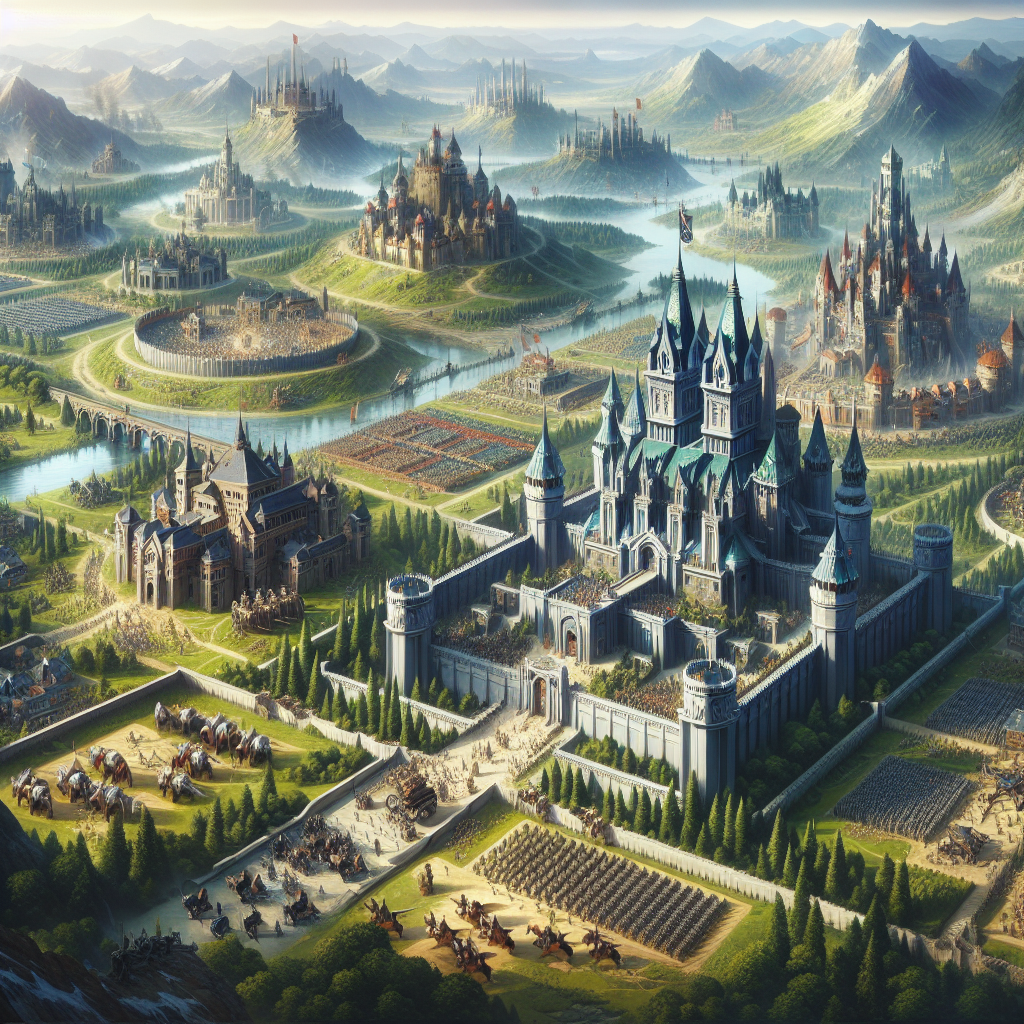“March of Empires” by Gameloft SE is a strategic mobile game that immerses players in a medieval world of conquest and empire-building. Version 4.3 of the game continues to enhance the experience with refined gameplay mechanics, new features, and improved graphics. Players can choose to lead one of several factions, each with unique strengths and abilities, as they build their empire, forge alliances, and engage in epic battles. The game combines resource management, tactical warfare, and diplomatic strategy, offering a comprehensive and engaging experience for fans of the genre.
Mastering Resource Management in March of Empires: Tips and Strategies
In the intricate world of March of Empires, a strategy game developed by Gameloft SE, mastering resource management is crucial for achieving dominance. As players navigate through the complexities of building and expanding their empires, understanding how to efficiently manage resources can make the difference between success and failure. This article delves into essential tips and strategies for optimizing resource management, ensuring that players can maintain a steady growth trajectory and outmaneuver their rivals.
To begin with, it is imperative to recognize the fundamental resources in March of Empires: food, wood, stone, iron, and silver. Each resource plays a vital role in the development and sustenance of an empire. Food is necessary for maintaining armies, wood and stone are essential for constructing buildings, iron is crucial for crafting weapons and armor, and silver is indispensable for various advanced upgrades and transactions. Balancing the production and consumption of these resources is the cornerstone of effective resource management.
One of the primary strategies for resource management is to prioritize the construction and upgrading of resource-generating buildings. Farms, lumber mills, quarries, iron mines, and silver mines should be developed early and consistently upgraded to ensure a steady flow of resources. Additionally, players should focus on research that enhances resource production. Technologies that increase the yield of farms, mills, and mines can significantly boost resource availability, providing a solid foundation for further expansion.
Moreover, efficient use of resources is equally important. Players should avoid overextending their resources on unnecessary upgrades or excessive troop training. Instead, a strategic approach should be adopted, where resources are allocated based on immediate and long-term needs. For instance, during periods of peace, it may be more beneficial to invest in infrastructure and research, whereas during times of conflict, prioritizing military upgrades and troop training becomes essential.
Another critical aspect of resource management is trade. Engaging in trade with other players can be a valuable means of acquiring scarce resources. Establishing alliances and negotiating trade agreements can provide access to resources that may be in short supply within one’s own empire. Furthermore, participating in events and completing quests can yield substantial resource rewards, offering an additional avenue for resource acquisition.
In addition to production and trade, resource protection is a vital component of resource management. Players must ensure that their resources are safeguarded from enemy raids. Building and upgrading defensive structures, such as walls and watchtowers, can deter potential attackers. Additionally, strategic placement of troops and regular scouting can help identify and neutralize threats before they can inflict significant damage.
Lastly, time management plays a crucial role in resource management. Players should take advantage of in-game timers and notifications to optimize their resource collection and usage. Setting reminders for when buildings and research projects are completed can help ensure that resources are not left idle. Additionally, planning resource-intensive activities during periods of high activity can maximize efficiency and minimize downtime.
In conclusion, mastering resource management in March of Empires requires a multifaceted approach that encompasses production, efficient use, trade, protection, and time management. By prioritizing the development of resource-generating buildings, engaging in strategic trade, safeguarding resources, and optimizing time management, players can ensure a steady flow of resources to support their empire’s growth and dominance. As players continue to refine their strategies and adapt to the dynamic challenges of the game, effective resource management will remain a pivotal factor in achieving success in March of Empires.
Top Alliance Building Techniques in March of Empires
In the dynamic world of March of Empires, a strategy game developed by Gameloft SE, the importance of building a strong alliance cannot be overstated. Alliances serve as the backbone of a player’s success, providing support, resources, and strategic advantages that are crucial for thriving in this competitive environment. To excel in this game, players must master the art of alliance building, which involves several key techniques that can significantly enhance their gameplay experience.
First and foremost, effective communication is the cornerstone of any successful alliance. Players must establish clear and consistent channels of communication to coordinate their efforts and share vital information. Utilizing in-game chat features, external messaging apps, or dedicated forums can facilitate this process. Regular communication ensures that all members are on the same page, enabling them to respond swiftly to threats and capitalize on opportunities. Moreover, fostering a culture of open dialogue and mutual respect within the alliance can strengthen bonds and promote a sense of camaraderie.
In addition to communication, strategic planning is essential for alliance success. Members should collaborate to develop comprehensive plans that outline their collective goals and the steps needed to achieve them. This includes setting priorities, such as resource gathering, territory expansion, and defense strategies. By aligning their individual efforts with the alliance’s overarching objectives, players can maximize their efficiency and effectiveness. Furthermore, regular meetings or strategy sessions can help to reassess and adjust plans as needed, ensuring that the alliance remains adaptable and resilient in the face of changing circumstances.
Resource sharing is another critical aspect of alliance building in March of Empires. Players should be willing to contribute their resources to support the collective needs of the alliance. This can involve sending troops to assist in battles, sharing surplus resources to aid in construction projects, or providing reinforcements during times of crisis. By pooling their resources, alliance members can achieve greater levels of progress and security than they could individually. Additionally, establishing a system for fair and equitable distribution of resources can prevent conflicts and ensure that all members benefit from the alliance’s collective efforts.
Leadership plays a pivotal role in the success of an alliance. Effective leaders must possess strong organizational skills, strategic acumen, and the ability to inspire and motivate their members. They should be able to make decisive decisions, delegate tasks appropriately, and mediate conflicts that may arise within the group. Moreover, leaders should lead by example, demonstrating commitment and dedication to the alliance’s goals. By fostering a positive and inclusive leadership style, they can cultivate a loyal and cohesive team that is capable of overcoming challenges and achieving greatness.
Finally, fostering a sense of community within the alliance can significantly enhance its overall effectiveness. Encouraging social interactions, celebrating achievements, and providing support during difficult times can strengthen the bonds between members. Organizing events, such as in-game competitions or social gatherings, can also promote a sense of unity and belonging. When members feel valued and connected, they are more likely to remain committed to the alliance and contribute to its success.
In conclusion, building a top-tier alliance in March of Empires requires a multifaceted approach that encompasses effective communication, strategic planning, resource sharing, strong leadership, and a sense of community. By mastering these techniques, players can create alliances that are not only powerful and resilient but also enjoyable and rewarding for all members. As they march forward together, these alliances can achieve remarkable feats and leave a lasting legacy in the world of March of Empires.
Advanced Combat Tactics for Dominating in March of Empires
In the intricate world of March of Empires by Gameloft SE, mastering advanced combat tactics is essential for players aiming to dominate the battlefield. As a strategy game that demands both foresight and adaptability, understanding the nuances of combat can significantly enhance your chances of success. To begin with, it is crucial to recognize the importance of troop composition. A balanced army, comprising infantry, cavalry, and archers, can adapt to various combat scenarios. Infantry units serve as the backbone, absorbing damage and holding the line, while cavalry units excel in flanking maneuvers and rapid assaults. Archers, on the other hand, provide crucial ranged support, weakening enemy forces before they can engage in close combat.
Transitioning from troop composition to battlefield positioning, the terrain plays a pivotal role in determining the outcome of battles. Utilizing high ground can provide a strategic advantage, as it enhances the effectiveness of ranged units and offers a defensive boost. Conversely, attacking from lower ground can put your forces at a disadvantage, making them more susceptible to enemy fire. Therefore, always strive to position your troops in a manner that maximizes their strengths while minimizing vulnerabilities.
In addition to positioning, timing is another critical factor in combat. Coordinating attacks with your allies can overwhelm opponents and disrupt their defensive strategies. For instance, launching a synchronized assault on multiple fronts can stretch enemy resources thin, forcing them to make difficult decisions about where to allocate their defenses. This tactic not only increases the likelihood of breaching enemy lines but also fosters a sense of unity and cooperation among your allies.
Moreover, the effective use of special abilities and hero skills can turn the tide of battle in your favor. Each hero in March of Empires possesses unique abilities that can provide significant advantages when used strategically. For example, some heroes can boost the morale and combat effectiveness of your troops, while others can debilitate enemy forces with powerful debuffs. Understanding the strengths and weaknesses of your heroes, and deploying them accordingly, can create opportunities to exploit enemy vulnerabilities and secure decisive victories.
Furthermore, intelligence gathering is an often-overlooked aspect of advanced combat tactics. Scouting enemy positions and gathering information about their troop composition and movements can provide invaluable insights. This knowledge allows you to tailor your strategies to counter specific threats and exploit weaknesses. For instance, if you discover that an enemy is heavily reliant on cavalry, you can adjust your troop composition to include more spearmen, who are particularly effective against mounted units.
Transitioning to resource management, maintaining a steady supply of resources is essential for sustaining prolonged military campaigns. Efficiently managing your economy ensures that you can continuously train and upgrade your troops, keeping them competitive against increasingly formidable opponents. Investing in resource-generating buildings and technologies can provide a steady stream of income, allowing you to focus on strategic planning and execution without the constant worry of resource shortages.
Finally, adaptability is the hallmark of a successful commander in March of Empires. The dynamic nature of the game means that strategies must evolve in response to changing circumstances. Being able to quickly assess the battlefield, make informed decisions, and adjust your tactics accordingly can make the difference between victory and defeat. By combining a deep understanding of troop composition, battlefield positioning, timing, hero abilities, intelligence gathering, resource management, and adaptability, players can develop advanced combat tactics that pave the way for dominance in March of Empires.”March of Empires” by Gameloft SE is a strategy game that offers a rich and immersive experience with its detailed graphics, complex gameplay mechanics, and a variety of strategic options. The game allows players to build and expand their empire, engage in battles, and form alliances, providing a comprehensive and engaging strategy experience. With a rating of 4.3, it is well-received by players, indicating a high level of satisfaction and enjoyment.





